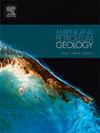新西兰塔拉纳基盆地近海中新世晚期深水海峡的地震地貌与演化
IF 3.7
2区 地球科学
Q1 GEOSCIENCES, MULTIDISCIPLINARY
引用次数: 0
摘要
深水航道将沉积物运往深海环境,在深海环境中发挥着重要作用,但同时也是油气储层。相比之下,传统的地震解释技术只能深入了解这些地貌;而错综复杂的通道填充异质性给揭示小地貌或相关要素带来了挑战。本研究整合了高分辨率三维地震数据、相对时间地质模型(RGT)、频谱分解和地质体,以确定中新世中晚期的海底通道、其演化过程及其相关沉积要素。地貌和地层分析结果显示了研究区域的四个沉积要素。这些沉积要素包括:(1)河道复合体;(2)集散河道;(3)正面飞溅河道复合体;(4)裂隙飞溅。然而,这些河道在河道堤岸外缺乏建筑堤坝,这与深部地区的沉积物供应有限有关。已发现的河道具有宽度从窄到宽(0.37 千米-1.92 千米)、蜿蜒度从低到高、切入深度适中以及横向迁移的特点。河道填充物的几何形状变化很大,表现为水平至次水平、横向增生、发散和倾斜反射包。大多数河道起源于塔拉纳基海岸线的东北方向和顺行的西南方向,河道宽大,在不同的发展阶段有不同的演变。河道填充物的基底振幅反射从中度到高度不等,表明河道中存在砂岩和泥岩等易起砂的混合岩层。光谱分解图显示出不同的颜色强度,这意味着通道内存在不同的岩层组合。河道的演变可能受到沉积物排放、断层、海平面变化、重力流强度变化以及大陆架边缘提供的物质类型等因素的影响。本文章由计算机程序翻译,如有差异,请以英文原文为准。
Seismic geomorphology and evolution of Mid-Late Miocene deepwater channels offshore Taranaki basin, New Zealand
Deepwater channels play a significant role in deep marine environments by transporting sediments to deep marine environments, but they are also hydrocarbon reservoirs. In contrast, traditional seismic interpretation techniques have provided insights into these features; intricate channel-fill heterogeneities present challenges in revealing small features or associated elements. This study integrates high-resolution 3D seismic data, relative time geologic models (RGT), spectral decomposition, and geobody to identify the Middle-late Miocene submarine channels, their evolution, and their associated deposition elements. The geomorphologic and stratigraphic analysis results have revealed four depositional elements in the study area. These include (1) channel complexes, (2) distributary channels, (3) frontal splay channel complexes, and (4) crevasse splays. However, the channels lack constructional levee development outside the channel banks, which is linked to the limited sediment supply to deep areas. The identified channels are characterized by a narrow to wide width (0.37 km–1.92 km), a low to high degree of sinuosity, medium incision depths, and lateral migration. The channel fill geometries are highly variable, displaying horizontal to sub-horizontal, lateral accretion, divergent, and inclined reflection packages. Most channels originate as large and wide channels from the northeast and prograde southwest direction of the Taranaki coastline, and they have evolved differently at different development stages. The channel fills exhibit a variable basal amplitude reflection, ranging from medium to high, indicating the presence of sand-prone and mixed facies, such as sand and mudstone. The spectral decomposition maps show variable color intensity, which implies different facies associations within the channels. The channel evolution is likely to be controlled by the interplay of sediment discharge, faults, sea level changes, variable gravity flow strength, and the type of materials supplied from the shelf edge.
求助全文
通过发布文献求助,成功后即可免费获取论文全文。
去求助
来源期刊

Marine and Petroleum Geology
地学-地球科学综合
CiteScore
8.80
自引率
14.30%
发文量
475
审稿时长
63 days
期刊介绍:
Marine and Petroleum Geology is the pre-eminent international forum for the exchange of multidisciplinary concepts, interpretations and techniques for all concerned with marine and petroleum geology in industry, government and academia. Rapid bimonthly publication allows early communications of papers or short communications to the geoscience community.
Marine and Petroleum Geology is essential reading for geologists, geophysicists and explorationists in industry, government and academia working in the following areas: marine geology; basin analysis and evaluation; organic geochemistry; reserve/resource estimation; seismic stratigraphy; thermal models of basic evolution; sedimentary geology; continental margins; geophysical interpretation; structural geology/tectonics; formation evaluation techniques; well logging.
 求助内容:
求助内容: 应助结果提醒方式:
应助结果提醒方式:


